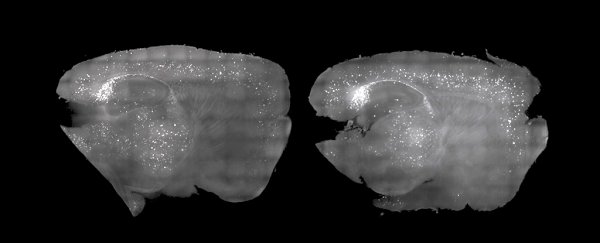Clumps of harmful proteins that interfere with brain functions have been partially cleared in mice using nothing but light and sound.
Research led by MIT has found strobe lights and a low pitched buzz can be used to recreate brain waves lost in the disease, which in turn remove plaque and improve cognitive function in mice engineered to display Alzheimer's-like behaviour.
It's a little like using light and sound to trigger their own brain waves to help fight the disease.
This technique hasn't been clinically trialled in humans as yet, so it's too soon to get excited - brain waves are known to work differently in humans and mice.
But, if replicated, these early results hint at a possible cheap and drug-free way to treat the common form of dementia.
So how does it work?
Advancing a previous study that showed flashing light 40 times a second into the eyes of engineered mice treated their version of Alzheimer's disease, researchers added sound of a similar frequency and found it dramatically improved their results.
"When we combine visual and auditory stimulation for a week, we see the engagement of the prefrontal cortex and a very dramatic reduction of amyloid," says Li-Huei Tsai, one of the researchers from MIT's Picower Institute for Learning and Memory.
It's not the first study to investigate the role sound can play in clearing the brain of the tangles and clumps of tau and amyloid proteins at least partially responsible for the disease.
Previous studies showed bursts of ultrasound make blood vessels leaky enough to allow powerful treatments to slip into the brain, while also encouraging the nervous system's waste-removal experts, microglia, to pick up the pace.
Several years ago, Tsai discovered light flickering at a frequency of about 40 flashes a second had similar benefits in mice engineered to build up amyloid in their brain's nerve cells.
"The result was so mind-boggling and so robust, it took a while for the idea to sink in, but we knew we needed to work out a way of trying out the same thing in humans," Tsai told Helen Thomson at Nature at the time.
The only problem was this effect was confined to visual parts of the brain, missing key areas that contribute to the formation and retrieval of memory.
While the method's practical applications looked a little limited, the results pointed to a way oscillations could help the brain recover from the grip of Alzheimer's disease.
As our brain's neurons transmit signals they also generate electromagnetic waves that help keep remote regions in sync - so-called 'brain waves'.
One such set of oscillations are defined as gamma-frequencies, rippling across the brain at around 30 to 90 waves per second. These brain waves are most active when we're paying close attention, searching our memories in order to make sense of what's going on.
Tsai's previous study had suggested these gamma waves are impeded in individuals with Alzheimer's, and might play a pivotal role in the pathology itself.
Light was just one way to trick the parts of the brain into humming in the key of gamma. Sounds can also manage this in other areas.
Instead of the high pitched scream of ultrasound, Tsui used a much lower droning noise of just 40 Hertz, a sound only just high enough for humans to hear.
Exposing their mouse subjects to just one hour of this monotonous buzz every day for a week led to a significant drop in the amount of amyloid build up in the auditory regions, while also stimulating those microglial cells and blood vessels.
"What we have demonstrated here is that we can use a totally different sensory modality to induce gamma oscillations in the brain," says Tsai.
As an added bonus, it also helped clear the nearby hippocampus – an important section associated with memory.
The effects weren't just evident in the test subjects' brain chemistry. Functionally, mice exposed to the treatment performed better in a range of cognitive tasks.
Adding the light therapy from the previous study saw an even more dramatic effect, clearing plaques in a number of areas across the brain, including in the prefrontal cortex. Those trash-clearing microglia also went to town.
"These microglia just pile on top of one another around the plaques," says Tsai.
Discovering new mechanisms in the way nervous systems clear waste and synchronise activity is a huge step forward in the development of treatments for all kinds of neurological disorders.
Translating discoveries like this to human brains will take more work, especially when there are potential contrasts in how gamma waves appear in mice and human Alzheimer's brains.
So far early testing for safety has shown the process seems to have no clear side effects.
This research was published in Cell.
